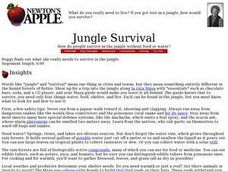Curated OER
Robot Earth
Young scholars construct a simple robotic energy transformer. In this space science lesson, students explain how energy is transformed from one form to another. They identify the different uses of robotic devices.
Curated OER
Classification of Clouds
High schoolers view progressive slides of cloud formations and identify which type of cloud is shown as it forms. They estimate the cloud's height while viewing each image.
Curated OER
What are the Challenges?
Students discuss energy. In this energy challenges instructional activity, students read about greenhouse gas emissions and global climate change. Comprehension questions from the reading are provided.
Curated OER
What Is In The Water?
Students investigate the biotic and abiotic factors that are found in an aquatic ecosystem. The emphasis is upon the investigation of present an projections of future water quality. Then students visit a local body of water to gather...
Curated OER
Transfer of Thermal Energy
In this thermal energy worksheet, students will explore different ways heat is transferred including conduction and convection. Students will look at how insulators work and how room temperature can affect heat transfer. This worksheet...
Curated OER
Reflection and Absorption of Light
Students use a microcomputer connected to a light sensor and temperature probe to explore the reflection and absorption of radiation for different surfaces. Students follow instructions in this guided inquiry based lab and are then asked...
Curated OER
Carbon Dioxide Heats It Up
Students design an investigation to test whether vegetation in an area helps regulate the ambient air temperature. They make comparisons between the investigation and global changes in climate. In groups, they present their findings to...
Curated OER
Explore! Fun with Science
Students explore the challenges of living in space by designing a facility that can provide everything required to support humans and can protect them from the harsh environment of space.
Curated OER
Does Humidity Affect Cloud Formation?
Young scholars use NASA's S'COOL database to identify factors that affect cloud formation.
Curated OER
Rain Reasons
Students explore how climatic factors influence the growth of plants. They create an experiment to find how variations in water, light, and temperature affect plant growth and describe how precipitation and geography can affect the...
Curated OER
Populations and Ecosystems
Sixth graders examine the factors that influence the stability of ecosystems. They construct a miniature ecosystem in a jar that includes plants, small fish, and snails, record the population changes over a period of four weeks, and...
Curated OER
Photosynthesis: Intake of Carbon Dioxide - Production of Oxygen
Students, after a long-term observation of photosynthesis with aquatic plants, assess the benefits of photosynthesis towards all living organisms. They explain in their own words the two cycles within photosynthesis. Guided discussion...
Curated OER
Jungle Survival
Students make a chart with columns for water, food, shelter, fire, and other needs.Then list whatever each person thinks they might need in each column to survive for at least a week in the outdoors during that season.
Curated OER
Crops 2: What Plants Need to Grow
Students explore the kinds of things that plants need to grow well.
Curated OER
How Warm is the Water?
Students research how surface sea temperature changes throughout the year. They draw a time series of sea surface temperatures for each month of the year and a depth profile for a summer and winter month using an OceanExplorer Profiler...
Curated OER
Webbing the Food Chain
Students compose a visual representation of the food chain cycle using Inspiration educational software.
Curated OER
The Water Cycle
Learners create an "animated" water cycle wheel that illustrates where water comes from and where it goes.
Curated OER
What Makes a Healthy Plant?
Young scholars predict the effects of water, light, and soil on the development of a plant and then design an experiment to test their predictions.
Curated OER
Water Quality Monitoring
Students comprehend the four parameters of water quality. They perform tests for salinity, dissolved oxygen, pH and clarity or turbidity. Students comprehend why scientists and environmental managers monitor water uality and aquatic...
Curated OER
Global Warming: The Greenhouse Effect Visualizer
Students work in small groups to study the various aspects of global weather and discuss the possibility of a Greenhouse Effect.
Curated OER
How Far Away is SOHO?
Students create a scale model of the Earth and the sun that demonstrates where the SOHO satellite is in relation to the Earth.
Curated OER
Every Tree For Itself
Fourth graders play a game where they are trees gathering sun, water, and nutrients and CO2 represented by pieces of paper or poker chips. They record their collected requirements and graph how they grew as a forest.
Curated OER
Robots from Junk
High schoolers create balloon and rubber band models of robotic rovers to investigate the concepts of mass, torque, and friction. Through research and planning, students construct a rover test-bed that simulates the Martian environment.

























